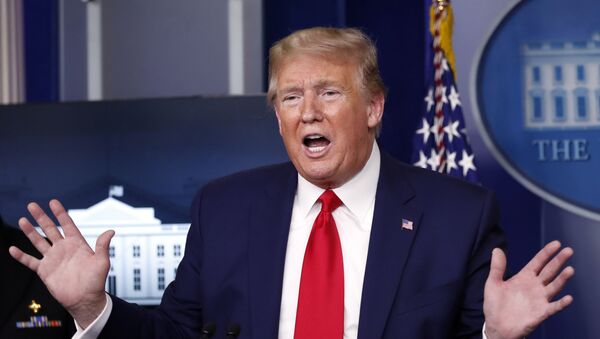"There are some people that don't want to do that much testing, but we're going maximum. We're going to the outer limits and I think the way that's probably it should be," Trump said.
— Aaron Rupar (@atrupar) April 20, 2020
"Remember it was all ventilators. And the reason it was all ventilators - they said there's no way they will ever be able to catch this one. And not only did we catch it, we are now the king of ventilators all over the world. We can send them anywhere. We have thousands being made a week and they were very high quality ... so, then they said testing, testing. We'll get him on testing. Well, testing is much easier than ventilators. Ventilators are big machines that are very complex and are very expensive ... You need a group of people that really know what they're doing ... but it used to be ventilators, ventilators, ventilators. Now, it's testing, testing, testing," Trump said, implying that complaints about testing in the US are attempts to damage him personally and politically.
Trump's comments come after US President Mike Pence said that the US has "enough testing capacity today for every state in America to go to Phase 1 if they meet the other criteria of 14 days of reduced cases and sufficient hospital capacity to prepare for any eventuality that may occur."
"Once again, we have enough testing capacity for every state in America to go to Phase 1, but we assured the governors today that we are going to continue to work around the clock to expand the testing capacity, support supplies and to support their efforts to encourage social distancing and the very mitigation efforts that the American people have been doing that have brought us the progress that we see all across the country today," Pence added.
— Steve Guest (@SteveGuest) April 20, 2020
Pence also said that the US Centers for Disease Control and Prevention (CDC) will be deploying to all US states to assist with testing and contact tracing.
Last week, Trump unveiled his "Guidelines for Opening Up America Again," a three-phased approach to restart American state economies. During Phase 1, "all vulnerable individuals should continue to shelter in place. Members of households with vulnerable residents should be aware that by returning to work or other environments where distancing is not practical, they could carry the virus back home. Precautions should be taken to isolate from vulnerable residents."
During Phase 1, employers should continue "to encourage telework, whenever possible and feasible with business operations." States and regions can only move to Phase 2 and then Phase 3 if there is "no evidence of a rebound" and they "satisfy the gating criteria a second time."
Gating criteria are divided into three subsections: symptoms, cases and hospitals. Gating symptoms criteria are defined as a "downward trajectory of influenza-like illnesses (ILI) reported within a 14-day period" and a "downward trajectory of COVID-like syndromic cases reported within a 14-day period."
Criteria under cases are as follows: "downward trajectory of documented cases within a 14-day period" and "downward trajectory of positive tests as a percent of total tests within a 14-day period (flat or increasing volume of tests)." Hospitals meet the criteria when they can "treat all patients without crisis care," and there is a "robust testing program in place for at-risk health care workers, including emerging antibody testing."
The US is currently facing the globe's worst coronavirus outbreak. The latest data by Worldometer reveals that there have been almost 800,000 confirmed cases in the country, and more than 42,000 COVID-related deaths have occurred.


